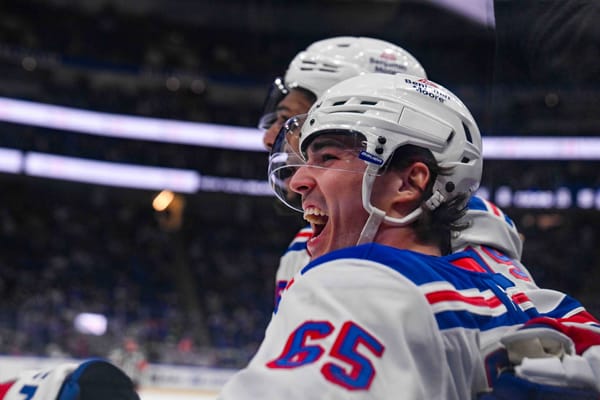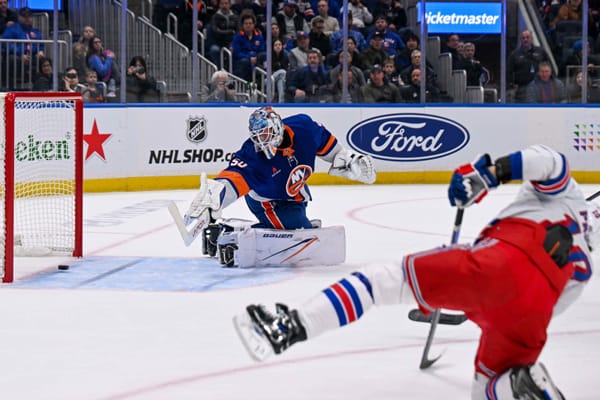Measuring Mats Zuccarello’s Value On and Off the Ice
Mats Zuccarello’s value to the New York Rangers, and in general, the hockey world, spans much deeper than his 352 points in 509 regular season games show. It also transcends what the team gained in trading the right winger.
For both his actions on and off the ice, Zuccarello emerged as a part of the Rangers’ core and quickly became a fan favorite — even more so in Norway, where his success in the NHL has already changed the landscape of hockey in his home country.
The trade to the Dallas Stars gives the undersized winger a chance to compete for the Stanley Cup, something he didn’t have in the immediate future while playing for the rebuilding Rangers. But if this marks the end of Zuccarello’s time in New York, he leaves a void in the lineup, locker room, and city.
Zuccarello first joined the Rangers in 2010. Up to that point, he had made an impact in GET-ligaen, a Norwegian hockey league, and the Swedish Elite League. While representing Team Norway at the 2010 Olympics, he caught the eye of the Rangers, and signed with them a few months later as an undrafted, 22 year old free agent.
With Zuccarello, the Rangers found talent outside of the draft — talent that first broke into the NHL in Dec. 2010, when he showcased his shootout abilities that he’s been known for ever since. But his first two NHL seasons were split between New York and the Rangers’ AHL affiliate in Connecticut, his second primarily in the latter. A broken wrist as a consequence of blocking a shot ended that second season short after being promoted, and put a bookend on his first NHL stint.
Zuccarello’s return to the Rangers, and tenure since, was highlighted by his growth as one of the Rangers’ best playmakers and most consistent producers. Along with leading the Rangers in scoring four times since his return to the team 2013-14, starting with a breakout season that year in which he led in scoring (59 points), assists (40), primary points (46), and 5-on-5 points (37), he won three Steven McDonald Extra Effort Awards for all that he contributes on the ice, including his skill, relentlessness, and tenacity for the puck.
Already an underdog because of his diminutive stature, Zuccarello beat the odds when he returned from a career-threatening injury suffered in the 2015 playoffs. As a result of his return, one that was followed by a season of hitting career-bests, the winger became even more cherished by New York.
Even through last season’s chaos, the right winger remained consistent, as he finished first in scoring with 53 points, 37 assists, and 39 primary points. Before being dealt to the Stars, Zuccarello was fourth on the team in scoring and ranked third in assists despite missing 15 games. Twenty-four of those points came after Jan. 10, when he began to get into a groove on the first line after trade rumors had thrown him off his game.
Throughout his tenure in New York, Zuccarello was both a consistent and leading scorer that was leaned on in all situations, and he was also their spark plug in all facets of the game — from how he played in his own end, to the offensive zone. The undersized winger has been towards the top of the teams’ rankings in takeaways because of how he’s been able to regain the puck, with some help from the extra length on his stick, and from there, transitioned it up the ice. The number of hits he’s absorbed over the years are indicative of just how much he’s possessed the puck.
And, there’s how Zuccarello’s sparks offense with his passing. For what he lacks in size, he more than makes up for in creativity; there are few players who see the ice as well as Zuccarello. His assist total always exceeds his goal total, and while he could stand to shoot his effective shot more often, his team’s offense is strengthened because of how he dishes the puck. His exceptional vision and how he anticipates a play developing allows him to create space for his teammates and find them with a threaded pass.
Along with that skill, Zuccarello’s heart and soul attitude that became one of the most essential pieces of the team’s core — a core that has become depleted over the years, with just four members of the 2014 team that reached the Stanley Cup Final remaining in Henrik Lundqvist, Marc Staal, Jesper Fast, and Kreider.
So how do the Rangers replace that?
Zuccarello the person can’t be replaced. That much was evident by how some of his teammates, including Lundqvist, reflected on the trade. The Rangers are a team that covets character and this subtraction leaves them without character that came without a sacrifice of skill. Others will try to step up their presence in the locker room, but everything that he’s contributed to the Rangers can’t be replicated. It opens an opportunity for others to step up in the locker room in their own way to rebuild their leadership core, like Kreider, Zibanejad, Brady Skjei, and down the line, even younger players like Lias Andersson and Brett Howden.
As for players that will try to fill the gap left in the lineup, there are some short-term options. For now, it’s with Jimmy Vesey moving up to the first line. It may also lead to increased time for players whose strengths are also how they see the ice and pass the puck, like Pavel Buchnevich or Filip Chytil.
As it stands, there’s no all-situation player who can replicate what the cerebral winger brings to a lineup, giving the Rangers something to look for this summer through the draft and offseason — and maybe, that ends up with them looking to bring him back for a third stint in New York. If not, it’s on the Rangers to find their “next Zuccarello” in terms of a winger that can be relied on. His departure highlights the importance of developing their own scoring wingers, and how important the evaluation of their current young players are — from Buchnevich and Chytil to extent if he stays on wing, to prospects like Vitali Kravtsov, and those yet to join the organization. But also it exposes the organizational need for scoring wingers, as depth on the wing isn’t a strength for the team, and subsequently, gives them something to focus on bolstering moving forward.
The Rangers have options in how they bolster that depth though. They can through the draft and via trade, but as Zuccarello’s initial signing demonstrated, it’s vital to look outside of the draft. As the 5-foot-7 winger and other undersized players around the league like Yanni Gourde and Tyler Johnson show, skill can be found in those that are often overlooked because of their size. It emphasizes of gambling on players with upside and developing them in the hopes that they can become a future key contributor like Zuccarello was the much of the last nine years.
Along with seeking players overlooked because of their size, his career stressed the importance of expanding a search for talent outside of the typical countries. Just eight Norwegians have made the NHL and only seven have skated in more than a single game. Zuccarello leads the way at 510, which is more than double the player behind him, Espen Knutsen. Along with longevity, he leads the way in every scoring category among Norwegian NHLers. The only category he trails is penalty minutes, which Ole-Kristian Tollefsen’s 296 minutes lead.
Zuccarello was the second Norwegian player to ever reach the NHL postseason, is the most accomplished of the three to skate in the playoffs with 60 appearances and 31 points, and the only one to ever skate in the Stanley Cup Final.
“Zuccarello is the most prominent player to ever come out of Norway. He leads all Norwegian players in games played, goals, points, and definitely in fans,” Roy Kvatningen, editor Nitten.no explained. “The fact that he dominated the Norwegian league, then the Swedish league and went on to do very well for one of the most famous sports franchises in the world, while keeping his sense of humor and down-to-earth-attitude has endeared him even to Norwegians who don’t follow sports.”
“He is one of the most popular athletes in Norway, which is impressive considering hockey is not a big deal here.” As for his impact on the game of hockey in the country, Kvatningen doesn’t think it’s something that can be comprehended yet. What can be seen so far, he explained, is how many kids can be seen throughout Norway with “Zuccarello” on the back of jerseys and how much youth hockey has grown since making his NHL debut.
It can also be seen by the response to his outdoor charity game with Lundqvist in Oslo last August. “A regular hockey game in Norway is attended by around 1500 on average… they sold 18,000 tickets. That’s even more than the Norwegian national team in soccer do. That’s how big Zuccarello’s standing is in Norway,” Kvatningen said.
Playing with the Ranges gave Zuccarello the opportunity to leave a lasting effect off the ice, both in New York and even more so in Norway from how he’s helped families with the Zuccarello Foundation, funded a Norwegian women’s team’s trip to the playoffs that they couldn’t afford, to how he’s been an ambassador for the the “You Can Play Project” and “Right to Play.”
Unfortunately, the organization made far too many costly mistakes over the years and he became a casualty of that — adding to the long list of core players that have made their way out of New York over the years, particularly in the last few as they’ve continued to rebuild.
The last nine years not only show Zuccarello’s growth in the NHL, but the possibilities that can stem from taking a gamble on skill, and investing and developing it. Now it’s time for the Rangers to continue planning for the future and keep their eyes open for talent wherever they can find it, so they don’t have to lose the next Zuccarello.




